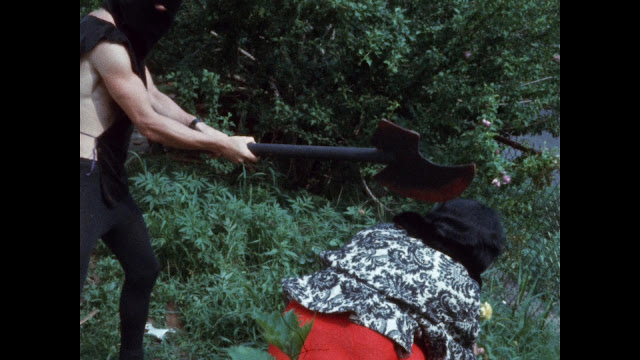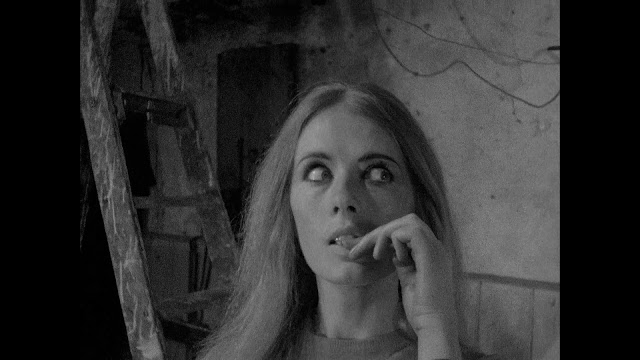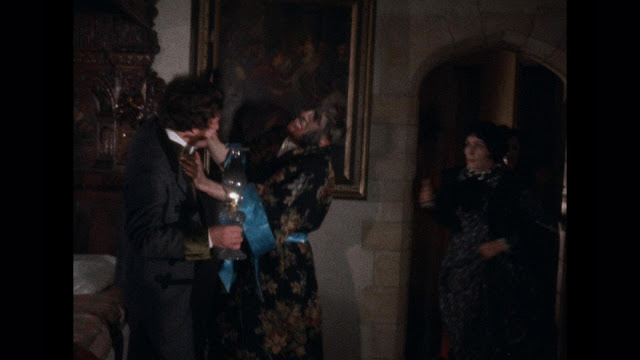Concluding my coverage of Severin Films' new, much coveted (and now officially OUT OF PRINT) box set, THE DUNGEON OF ANDY MILLIGAN COLLECTION...
The remaining important restorations in this comprehensive collection are the infamous double feature of BLOODTHIRSTY BUTCHERS and TORTURE DUNGEON (both 1970), each of which forfeited about a minute's worth of poorly executed gore effects to qualify for R ratings; and LEGEND OF BLOOD (1977), a more competent if less characteristic remake of THE GHASTLY ONES, previously available only in a cropped and emasculated TV version known as LEGACY OF HORROR.
 |
| Lady Jane and Lady Agatha (Patricia Dillon and Donna Whitfield) confer in TORTURE DUNGEON. |
Filmed under the far less-pungent title MACABRE, TORTURE DUNGEON (1970, 80m 22s) was the first of these three titles to be produced. It was made just prior to Milligan's London sojourn in the late summer of 1968, while BLOODTHIRSTY BUTCHERS (made as THE DEMONS, a loose adaptation of the Sweeney Todd story) was one of Milligan's five British productions, filmed (according to Stephen Thrower) over seven days in February/March 1969, with two days of additional shooting back in New York.
The unabashedly sleazy advertising campaign that trumpeted these two films some 50 years ago, genuine masterpieces of the sleazier side of showmanship, tend to eclipse the reality of the films themselves. I always expect I'll enjoy them more than I do whenever I revisit them. Now that I've finally seen everything these two films have to offer in their most complete form, I can see how their former abundance of blunt splices added to their mystique, raising false hopes; those jumps and zips and thuds in the film stock encouraged unrealistic fantasies, engendering dreams and fantasies far more odious and transgressive than was ever really the case. As these restored versions prove, the gore was haplessly, even predictably executed and the most important footage restored to either film is not of a tongue being torn out but of a tongue being lovingly slipped into Ivan's mouth as he is kissed by the evil Duke of Norwich.
TORTURE DUNGEON is accompanied by an audio commentary by Alex DiSanto, who improvises his talk around notes - only intermittently commenting directly about what is happening or who has walked onscreen. He is so good on certain individual details, like recognizing Ivan's homemade hunchback prosthesis as dating back to Milligan's lost film THE NAKED WITCH, that it's disappointing when he completely overlooks what I was most looking forward to hearing more about: the simply unbelievable, uncredited performance of whoever played Magda, the marriage counselor who suddenly flits into the film like a ghastly human butterfly, holding us as incredulous captives for more than five show-stopping minutes, in which she (?) presumes to advise Susan Cassidy's sluttish Heather about the birds and the bees prior to her wedding to the nose-picking Albert.
 |
| The unbelievable Magda in TORTURE DUNGEON's most WTF moment, which lasts a full five minutes. |
Though DiSanto doesn't take Milligan's "ditties" especially seriously, he has obviously spent time in researching them; he mentions watching certain films in the company of John Borske and his wife Patricia Dillon, both of whom worked on this picture, and he was also called upon by Severin Films to assist in the restorations of the "negatives" (16mm camera reversals) of Milligan's uncut materials. Unfortunately what stands out most about his sometimes catty talk are those times when he crosses a couple of lines I wish he hadn't.
About 22 minutes into the commentary, DiSanto prepares us for what is to come by saying that "a lot" of what he's about to say "should probably be taken with a grain of salt" because he'll be passing along information obtained from people who were there, or who say they were there, or maybe heard this from someone who said they were on the set. He then adds that at least he's "being honest" by saying this up front - not like other commentators, who, according to him, just put what they think they know out there as fact.
 |
| The great Maggie Rogers as the Margaret, the One-Eyed Hag. |
DiSanto proceeds to tell some fast-and-loose stories about the late William Mishkin, who produced about a dozen of Milligan's films - that is, enabled them to exist. He initially refers to Mishkin with his full name... then he becomes the informal "Bill"... and before you know it, he's referring to him as "the fucker" - never mind the fact that DiSanto is here representing a Mishkin production on disc as its official audio commentator. True, Hal Borske's GHASTLY ONES commentary may be even more outrageous, but he has Frank Henenlotter sharing his track with laughter and other feedback that keeps the discussion light, upbeat, ironic, and ridiculous. Besides, Hal was there. He wasn't always paid, even when he got set on fire either. So he's entitled. I found DiSanto's presumption disturbing.
At the same time, in the course of writing about this, I began to think to myself that maybe this voice needs to be here, after all. I'm not proposing that more people adopt DiSanto's approach, but if Milligan discussion is to remain at all realistic, it's got to maintain its connection to its its gay roots, its Off Off Broadway roots, its theatricality, its bitchy braggadoccio, even its seething anger, resentment, and paranoia. As more people fall under the spell of these curiosities and write about them, whether casually or academically, that work is bound to generate ever newer and more personal takes on what these films are, what they mean, and who made them; and in so doing, they will inevitably gain distance from their real point of origin. Regardless of some errors in taste, tact, and decorum, DiSanto probably grounds this film to a more representative spirit than a more correct, responsible commentary would have done.
 |
| Sweeney Todd (John Miranda) at work, censored in earlier releases. |
Like TORTURE DUNGEON, BLOODTHIRSTY BUTCHERS (1970, 79m 40s) holds a prominent place in Milligan's filmography given its once wide release, but it fails to live up to its ad campaign or reputation, even with a minute's worth of graphic violence (its whole raison d'être in one minute!) restored to it. Still, the picture serves as confirmation that Tod Slaughter was one of Milligan's chief influences and it's impressive how many characters and how much incident is crammed into its meager running time.
To wit: Sweeney Todd's (John Miranda) barber shop provides gristle for the meat pie mill run by his shrewish mistress Maggie Lovett (Jane Hilary), who is forced to work with her sneering butcher Tobias (Berwick Kaler) after her husband (Jonathan Holt) has returned from the war an invalid; Tobias is scheming and sleeping with the amoral, foul-mouthed Rose (Ann Arrow) while lusting after the more wholesome shopgirl Johanna Jeffrey (Annabella Wood), who cannot contain her girlish libido upon the homecoming of her her handsome fiancé Jarvis (Michael Cox). In addition to sleeping with Maggie, Sweeney is two-timing his alcoholic wife Becky (Susan Driver) with Anna (Susan Cassidy), an ambitious, short but huge-legged music hall singer actress who is also in bed with her theater manager (Frank Echols), who has promised her name up in lights; and, in addition to all this, we have the non-stop traffic of Maggie's clientele, who love to gossip and at least one of whom - a gibbering, Renfield sort of person named Mr. Busker (William Barrel) - seems hooked on Maggie's product and seems dementedly aware of their secret recipe. Several of these foregrounded characters come and go in a blur, and even some of the major characters are less involved than you might expect, but one in particular - Corky (George Barry), a fellow music hall performer at Anna's theater who's drenched in sweat and melting drag makeup, interrupts the film and stands center stage for a few minutes in a vivid if non sequitur character sketch that speaks warmly and with feeling to the fraternity of actors who find themselves working in dumps.
 |
| Berwick Kaler as the feral (and sometimes careless) pie maker Tobias. |
 |
| Frank Echols and Susan Cassidy backstage at the music hall, in Anna's cluttered closet of a dressing room. |
 |
| Sweeney and Anna listen as Corky (George Barry) steals his scene. |
 |
| Careful with that cutlery in the kitchen! |
 |
| Elaine Boies and Marilee Troncone as the Lennox sisters, caretakers of the Hanley estate. |
Made directly after BLOOD (his first film in 35mm) in 1977, LEGACY OF BLOOD (77m 34s) was Milligan's first wholly self-produced feature, based on a rewrite of his breakthrough horror film THE GHASTLY ONES. Until now, this version had never been seen, having been superseded in release by its slightly longer TV version LEGACY OF HORROR (83m 2s). As we learn from Hal Borske's commentary for THE GHASTLY ONES, that film's opening scene featuring his murderous attack on a couple parading under a gaudy parasol was added to the film some time after it was completed, at the insistence of William Miskin who felt it needed more (and earlier) graphic horror. A similar scene does not open LEGACY OF BLOOD, which therefore gives us a sense of how THE GHASTLY ONES must have played in the version originally presented to Mishkin - that is, without any element of horror whatever for the film's first 48 minutes! The character names are all changed and some new material is also added, such as an early scene in which the troglodytic Carl (Chris Broderick as the analog to the Hal Borske character Colin) is lured by a nasty group of youngsters to an elevated footpath where they toss him over the edge just for kicks - an exposé of cruelty among "normal people" that would grow even more malicious in Milligan's Los Angeles films THE WEIRDO and MONSTROSITY. Milligan also surprises us here with another cameo appearance, this time as a mailman whose outward kindliness masks an appetite for petty theft.
 |
| Carl (Chris Broderick) takes a hard fall. |
 |
| The Hanley heiresses and their husbands at the train station. Pay no attention to the modern day train behind them! |
In its TV version, there isn't much to admire about this film but its redundancy. However, as presented here, the film is not only the beneficiary of some zestful restored violence but also of its intended 1.78:1 framing, which is a vast pictorial improvement over anything we've previously seen. The film has been given a 2K restoration using its only known 35mm print, held in the collection of producer Ken Lane. The compositions throughout are surprisingly competent and work well toward the telling of a story that actually holds one's attention - which is saying a lot, considering for how long Milligan withholds the juicy incident we're expecting to see. Even the family lawyer (Martin Reymert), a grotesque figure out of a Charles Dickens nightmare in THE GHASTLY ONES, is a normal looking man. As we wait for the murders to kick in, there are still things to raise our chuckles - the horribly cramped foyer used as a restaurant entrance, which leads to an interior with a single dining room table; the scene at Staten Island's Tottenville train station where our cast of characters (in 1920s dress) await their train while huddled tightly together to block our view of a still-somewhat-visible contemporary train car; the man using a candlestick to navigate fairly bright darkness who lowers himself to examine something on the floor - right next to an electrical socket; and the miscasting of ultra-fey Joe Downing as the uber-frisky James Smith, whose sexual appetite for his wife Regina (Dale Hansen) is expressed in several funny ways. When the hooded phantom killer is finally unmasked and embarks on a long origin speech, the soliloquy now takes place right next to a fire on the stairs that's getting out of control - and everyone is so politely listening that no one does anything to put it out.
 LEGACY OF BLOOD takes a sudden turn toward horror in its last 30 minutes. |
Subscribe to Tim Lucas / Video WatchBlog by Email
If you enjoy Video WatchBlog, your kind support will help to ensure its continued frequency and broader reach of coverage.






































